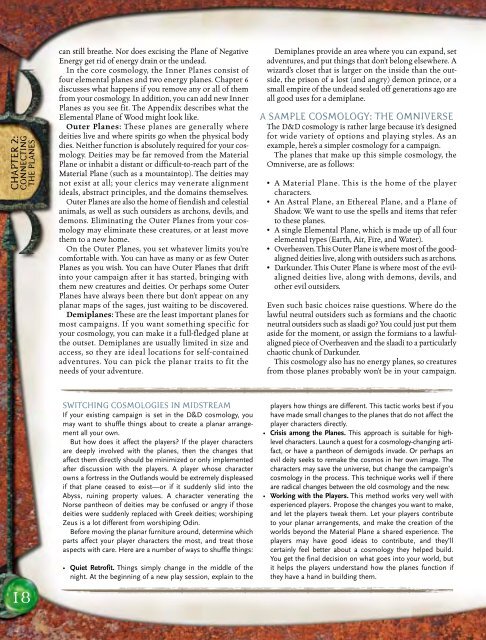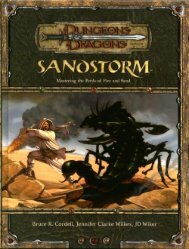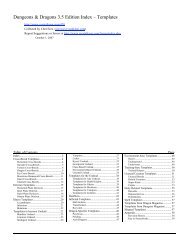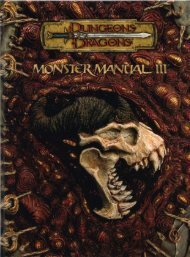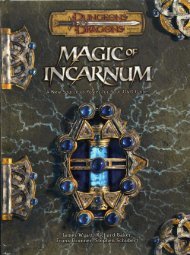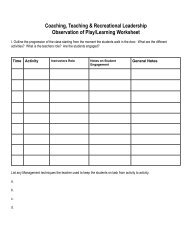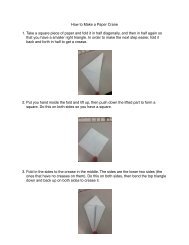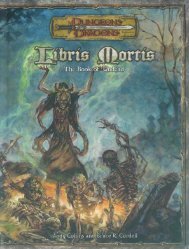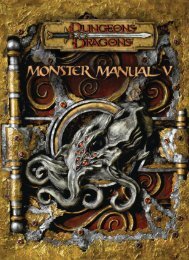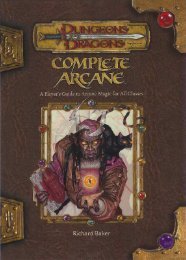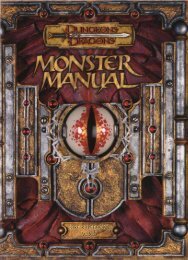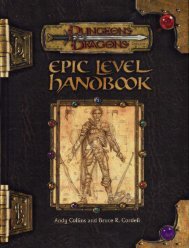Manual of the Planes
Manual of the Planes
Manual of the Planes
- No tags were found...
Create successful ePaper yourself
Turn your PDF publications into a flip-book with our unique Google optimized e-Paper software.
CHAPTER 2:CONNECTINGTHE PLANEScan still brea<strong>the</strong>. Nor does excising <strong>the</strong> Plane <strong>of</strong> NegativeEnergy get rid <strong>of</strong> energy drain or <strong>the</strong> undead.In <strong>the</strong> core cosmology, <strong>the</strong> Inner <strong>Planes</strong> consist <strong>of</strong>four elemental planes and two energy planes. Chapter 6discusses what happens if you remove any or all <strong>of</strong> <strong>the</strong>mfrom your cosmology. In addition, you can add new Inner<strong>Planes</strong> as you see fit. The Appendix describes what <strong>the</strong>Elemental Plane <strong>of</strong> Wood might look like.Outer <strong>Planes</strong>: These planes are generally wheredeities live and where spirits go when <strong>the</strong> physical bodydies. Nei<strong>the</strong>r function is absolutely required for your cosmology.Deities may be far removed from <strong>the</strong> MaterialPlane or inhabit a distant or difficult-to-reach part <strong>of</strong> <strong>the</strong>Material Plane (such as a mountaintop). The deities maynot exist at all; your clerics may venerate alignmentideals, abstract principles, and <strong>the</strong> domains <strong>the</strong>mselves.Outer <strong>Planes</strong> are also <strong>the</strong> home <strong>of</strong> fiendish and celestialanimals, as well as such outsiders as archons, devils, anddemons. Eliminating <strong>the</strong> Outer <strong>Planes</strong> from your cosmologymay eliminate <strong>the</strong>se creatures, or at least move<strong>the</strong>m to a new home.On <strong>the</strong> Outer <strong>Planes</strong>, you set whatever limits you’recomfortable with. You can have as many or as few Outer<strong>Planes</strong> as you wish. You can have Outer <strong>Planes</strong> that driftinto your campaign after it has started, bringing with<strong>the</strong>m new creatures and deities. Or perhaps some Outer<strong>Planes</strong> have always been <strong>the</strong>re but don’t appear on anyplanar maps <strong>of</strong> <strong>the</strong> sages, just waiting to be discovered.Demiplanes: These are <strong>the</strong> least important planes formost campaigns. If you want something specific foryour cosmology, you can make it a full-fledged plane at<strong>the</strong> outset. Demiplanes are usually limited in size andaccess, so <strong>the</strong>y are ideal locations for self-containedadventures. You can pick <strong>the</strong> planar traits to fit <strong>the</strong>needs <strong>of</strong> your adventure.Demiplanes provide an area where you can expand, setadventures, and put things that don’t belong elsewhere. Awizard’s closet that is larger on <strong>the</strong> inside than <strong>the</strong> outside,<strong>the</strong> prison <strong>of</strong> a lost (and angry) demon prince, or asmall empire <strong>of</strong> <strong>the</strong> undead sealed <strong>of</strong>f generations ago areall good uses for a demiplane.A SAMPLE COSMOLOGY: THE OMNIVERSEThe D&D cosmology is ra<strong>the</strong>r large because it’s designedfor wide variety <strong>of</strong> options and playing styles. As anexample, here’s a simpler cosmology for a campaign.The planes that make up this simple cosmology, <strong>the</strong>Omniverse, are as follows:• A Material Plane. This is <strong>the</strong> home <strong>of</strong> <strong>the</strong> playercharacters.• An Astral Plane, an E<strong>the</strong>real Plane, and a Plane <strong>of</strong>Shadow. We want to use <strong>the</strong> spells and items that referto <strong>the</strong>se planes.• A single Elemental Plane, which is made up <strong>of</strong> all fourelemental types (Earth, Air, Fire, and Water).• Overheaven. This Outer Plane is where most <strong>of</strong> <strong>the</strong> goodaligneddeities live, along with outsiders such as archons.• Darkunder. This Outer Plane is where most <strong>of</strong> <strong>the</strong> evilaligneddeities live, along with demons, devils, ando<strong>the</strong>r evil outsiders.Even such basic choices raise questions. Where do <strong>the</strong>lawful neutral outsiders such as formians and <strong>the</strong> chaoticneutral outsiders such as slaadi go? You could just put <strong>the</strong>maside for <strong>the</strong> moment, or assign <strong>the</strong> formians to a lawfulalignedpiece <strong>of</strong> Overheaven and <strong>the</strong> slaadi to a particularlychaotic chunk <strong>of</strong> Darkunder.This cosmology also has no energy planes, so creaturesfrom those planes probably won’t be in your campaign.pqqqqrs18SWITCHING COSMOLOGIES IN MIDSTREAMIf your existing campaign is set in <strong>the</strong> D&D cosmology, youmay want to shuffle things about to create a planar arrangementall your own.But how does it affect <strong>the</strong> players? If <strong>the</strong> player charactersare deeply involved with <strong>the</strong> planes, <strong>the</strong>n <strong>the</strong> changes thataffect <strong>the</strong>m directly should be minimized or only implementedafter discussion with <strong>the</strong> players. A player whose characterowns a fortress in <strong>the</strong> Outlands would be extremely displeasedif that plane ceased to exist—or if it suddenly slid into <strong>the</strong>Abyss, ruining property values. A character venerating <strong>the</strong>Norse pan<strong>the</strong>on <strong>of</strong> deities may be confused or angry if thosedeities were suddenly replaced with Greek deities; worshipingZeus is a lot different from worshiping Odin.Before moving <strong>the</strong> planar furniture around, determine whichparts affect your player characters <strong>the</strong> most, and treat thoseaspects with care. Here are a number <strong>of</strong> ways to shuffle things:players how things are different. This tactic works best if youhave made small changes to <strong>the</strong> planes that do not affect <strong>the</strong>player characters directly.• Crisis among <strong>the</strong> <strong>Planes</strong>. This approach is suitable for highlevelcharacters. Launch a quest for a cosmology-changing artifact,or have a pan<strong>the</strong>on <strong>of</strong> demigods invade. Or perhaps anevil deity seeks to remake <strong>the</strong> cosmos in her own image. Thecharacters may save <strong>the</strong> universe, but change <strong>the</strong> campaign’scosmology in <strong>the</strong> process. This technique works well if <strong>the</strong>reare radical changes between <strong>the</strong> old cosmology and <strong>the</strong> new.• Working with <strong>the</strong> Players. This method works very well wi<strong>the</strong>xperienced players. Propose <strong>the</strong> changes you want to make,and let <strong>the</strong> players tweak <strong>the</strong>m. Let your players contributeto your planar arrangements, and make <strong>the</strong> creation <strong>of</strong> <strong>the</strong>worlds beyond <strong>the</strong> Material Plane a shared experience. Theplayers may have good ideas to contribute, and <strong>the</strong>y’llcertainly feel better about a cosmology <strong>the</strong>y helped build.You get <strong>the</strong> final decision on what goes into your world, butit helps <strong>the</strong> players understand how <strong>the</strong> planes function if<strong>the</strong>y have a hand in building <strong>the</strong>m.• Quiet Retr<strong>of</strong>it. Things simply change in <strong>the</strong> middle <strong>of</strong> <strong>the</strong>night. At <strong>the</strong> beginning <strong>of</strong> a new play session, explain to <strong>the</strong>pqqqqrs


